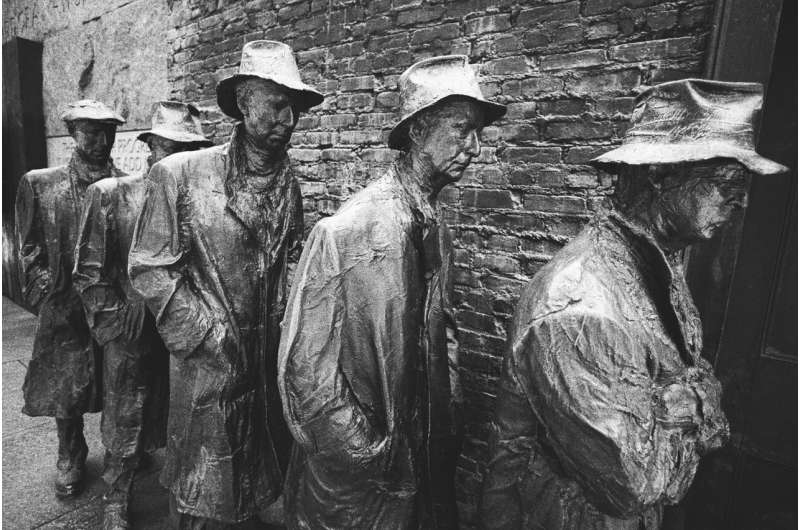This article has been reviewed according to Science X's editorial process and policies. Editors have highlighted the following attributes while ensuring the content's credibility:
fact-checked
trusted source
proofread
Study examines how ad strategies of the Great Depression can inform today's crisis communications

The COVID-19 pandemic was not the first time a crisis swept through the nation and beyond, forcing businesses and media to find ways to reach people in uncertain times. A new study from the University of Kansas has analyzed newspaper advertising strategies from the Great Depression to see what one historic crisis can teach communicators about reaching people today.
Researchers analyzed newspaper ads from Dust Bowl states during 1934 to see how businesses and companies tried to reach consumers.
Results showed essential services, such as utilities, banks, and transportation companies, used informational and rational strategies, while nonessential services, such as tobacco and cosmetics companies, tended to use transformational and sensory approaches. While the times and technologies of the two eras were different, lessons learned can both help communicators avoid mistakes of the past and consider new ways to communicate with people during times of crisis.
"It was interesting to me to think about how, during COVID, so many newspapers turned to the 1918 influenza pandemic to see what they could learn. But nobody seemed to really look at the advertising side," said Teri Finneman, associate professor of journalism & mass communications at KU. "We saw a lot of lessons to be learned from the Great Depression when American society and media were dealing with the economic crisis and the Dust Bowl, two major catastrophes, at the same time."
Chloe Martens, a recent graduate of KU, was taking Finneman's journalism history class and conducted a pilot analysis of advertising strategies during the Depression for her final project. The project became "Is It Smart to Be Thrifty?: How Advertisers Navigated Message Strategies During the Great Depression," recently published in the journal Journalism History.
The study, written by Finneman, Vaibhav Diwanji, assistant professor; Melissa Greene-Blye, assistant professor; and Martens, all of KU, analyzed newspaper ads from the year 1934 published in Nebraska, Colorado, Kansas, Oklahoma, New Mexico, and Texas. The states were chosen as they were the epicenter of the Dust Bowl crisis, while 1934 was selected as the timeframe because it was one of the most financially and economically devastating years of the Depression.
Analysis showed brands continued to advertise and used psychological approaches to appeal to people at that particular time in history. Banks, which took much of the blame for the financial struggles of the time, tended to use reassurance as a theme, urging people to trust them as they struggled with the people.
Some ads saw claims of banks investing one dollar of their own for every four deposited by consumers. One featured a drawing of President Franklin Delano Roosevelt shaking hands with Baby New Year and promising that next year would be better for everyone.
Advertisements for nonessential products like tobacco or cosmetics appealed to people's senses, rights to feel good despite hard times, and transformation from difficult circumstances. Cosmetics ads assured women their products could help them move to higher social classes, while cigarette ads claimed their products could make people feel better and even deliver health benefits.
Newspapers were not immune from the struggles of the era, and Greene-Blye, a media historian, noted how publications engaged in boosterism, or positioning themselves as essential to people's lives, especially during difficult times. That echoed an earlier time in American history. As communities were established in the 19th century, a newspaper was viewed as key to having a successful city.
"They positioned themselves as the best way to find the most important information," Greene-Blye said. "'Of all things you might sacrifice, not your newspaper.' Not only because they would find the best information there, but because they'd find the best deals."
And times of financial hardship, finding deals is especially important to consumers. Advertisers repeatedly touted not only their own good prices but the acceptability of thrift as a practice, hence the title of the study.
Diwanji, who has studied advertising and messaging during the pandemic, said there were parallels between advertising during the Depression and the more recent pandemic.
"A lot of ads during the pandemic were focusing on 'staycations.' Saying things like, 'Even if you're stuck at home, you still deserve to feel good.' That is similar to how we saw tobacco ads promoting health," Diwanji said. "They were trying to distract from the tragic position and focus less on the problems 'out there' and more on economic or social betterment."
Understanding what types of approaches work in times of crisis can benefit advertisers and consumers, the authors wrote.
"The two sides get disconnected, especially in times of crisis," Diwanji said of advertisers and consumers. "We saw during the pandemic how many institutions simply went silent or went with a bland 'we're all in this together' message and got criticized for being tone-deaf. Understanding past approaches can help avoid that type of criticism and get people the information they need."
More information: Teri Finneman et al, "Is It Smart to Be Thrifty?": How Advertisers Navigated Message Strategies During the Great Depression, Journalism History (2023). DOI: 10.1080/00947679.2023.2270890
Provided by University of Kansas



















